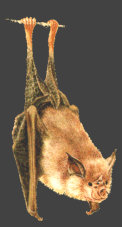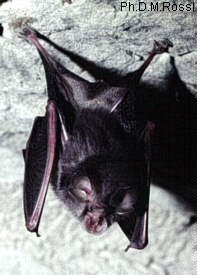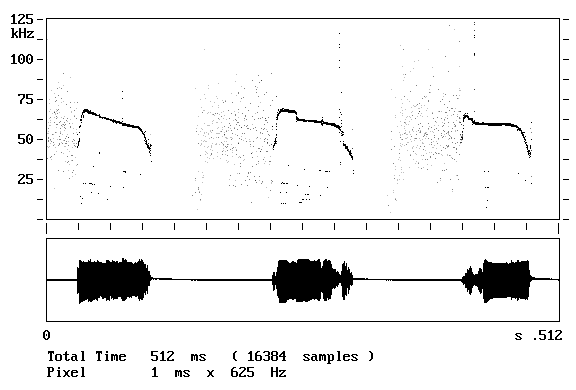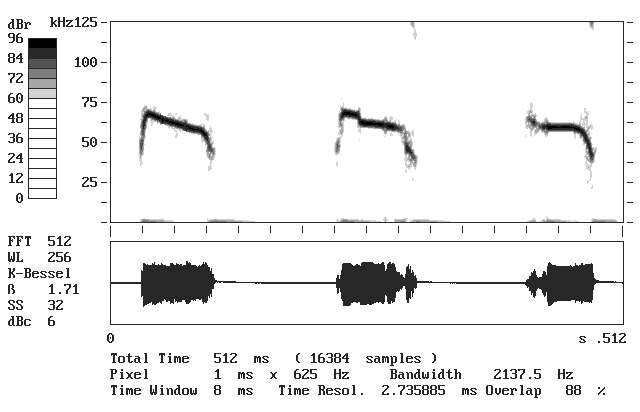
Università degli Studi di Pavia
Centro Interdisciplinare di Bioacustica e Ricerche Ambientali
Via Taramelli 24 - 27100 Pavia - Italye-mail : cibra@unipv.it
Mammals, Mammalia
Our main interest, as you should know at this point, are cetaceans. Their calls and echolocation signals are well known (we care about them in another page). Other mammals we have recorded and studied, for different purposes, are bats, deers and mice.
It is very difficoult to study complex sounds as those produced by mammals. This because the social context in which sounds have importance is much more variable than the one we find in animal with simpler behaviour. Individual learning and experience, condition the developement of communication abilities and language expression. The message carries a meaning not only referred to the syntax and vocabulary used, but referred to emotional, physical, social and environmental conditions in which the animal acts too.
This is true following the growth of
behavioural complexity.
Today is possible to study sounds produced in very
specific contexts, like mating or sonar surveing. These
sounds, expecially the second, are more uniform because
constrained by physical unvariable laws. And so they are
more easily comparable.
So, go on and read about:
Chiroptera, bats
 Bats are the only flying
mammals. There are small bats, microchiroptera,
which are mostly insectivorous, and large bats, megachiroptera,
which eat fruit. In Europe exist insectivorous bats only.
Bats are the only flying
mammals. There are small bats, microchiroptera,
which are mostly insectivorous, and large bats, megachiroptera,
which eat fruit. In Europe exist insectivorous bats only.
Insects are detected by the means of a natural sonar. The first man who understood the existence of a different "sense" in bats was abbot Lazzaro Spallanzani in 1776.
Spallanzani, who lived and worked in Pavia (the city I am writing from), experimented the behaviour of blinded / deafened bats, and then wrote his "letter on the suspect of a new sense in bats".
This sense was named echolocation by Donald Griffin in the '40s, about 150 years later.
The evolution of echolocation is intriguing. We do not know how bats evolved their sonar. There are many hypothesis.
We can anyway see how different species use two main different techniques: constant frequency (CF) sonar and modulated frequency (MF) sonar. Each one of the two has its own advantages and disadvantages.
Probably the most important advantage in costant frequency biosonar is a very precise determination of relative speed between bat and insect. This depending on the Doppler effect. On the other hand, probably, the most important advantage in frequency modulated sonars is a very good knowledge of the object size and distribution in the three dimensions.
Above all we can evaluate the success of this kind of specialization by looking at a taxonomic table of bats. There are about 1000 species of bats in the world. And that's a great success.
The acoustic activity of bats is very interesting. As they live in dark places (caves, holes and roofs), and fly at nightime, they use their detection system both to orientate and to prey.
The most important component in their sonar is ultrasonic, and this permits a very precise location of small targets (i.e. a flying insect). The clicks we can listen to, sometimes when we look at them in flight, are the lower part (in frequency) of the whole echolocation signal. In the caves (and in any other roosting site) it may happen to hear much louder whistles. These are social calls, which are lower in frequency, and so more audible for us.
We have recorded several species of bats, and many others have been recorded by other laboratories. It is hard to recognize different species by their sounds. On the other hand it is quite easy to make a population (or an area) survey by recording ultrasounds.

To listen to and record ultrasounds it is necessary to have a special equipment. You can use an ultrasound recorder, a bat detector or a digital high speed acquisition card on a computer.
The species studied are many, among the others we have recordings of:
- Rhinolophus ferrumequinum
- Pipistrellus pipistrellus
- Myotis
Listen to...
Download a sample of our sound library.
Horseshoe bat, Rhinolophus ferrumequinum biosonar.
Spectrogram 1, spectrogram 2 and sound (*.AU format).
recorded in northern Italy, fall 1992.
This recording was made with a frequency division bat
detector. The division factor is 10, so the real
frequency is ten times higher. This a good example of a
Costant Frequency biosonar. The frequency is centered on
83 kHz.
Modulated frequency biosonar, maybe a surveying
Pipistrellus pipistrellus. Spectrogram and sound (*.AU format).
recorded in northern Italy, summer 1992.
This recording was made with a frequency division bat
detector. The division factor is 10, so the real
frequency is ten times higher. This a good example of a
Modulated Frequency biosonar.
If you are interested in bats, you can jump to the Bristol
(U.K.) Bat Echology and Bioacoustics Laboratory.
New low cost tools are now available for recording
bats... see the dodotronic
ultrasonic microphones and our new freeware SeaWave software
Artiodactyla, Cervidae, Cervus elaphus
In 1995 and 1997 we began recording deer calls in the Cansiglio Forest to evaluate the feasibility of individual acoustic recognition.

The spectrogram shows the two main sound types used by the red deer in the breeding season: the "roars" and "coughs". Recording made with ultradirectional microphone connected to a portable DAT recorder. Download the recording matching this spectrogram (WAV 1.15MB, MP3 184KB).
More recently (2001-2011) deer calls have been
extensively recorded in consecutive breeding seasons by
Andrea Favaretto and Gianni Pavan to study individual
acoustic features and to describe the population
repertoire. The study area is in "Foresta del Cansiglio" a
protected area on the Italian Alps. The research is done
in cooperation with the CFS (Italian Forestry Police) and
is producing interesting results (paper in preparation).
Recording at night in very cold and wet conditions was an
occasion to test different equipments, including the use
of laptop-based multichannel recording for sound
localization.
Enjoy some sample recordings now available on SoundCloud
Rodentia, Mus musculus
For the first two weeks of their life newly born mice can't termoregulate and need to stay warm in the nest with the mother. If they leave the nest and become cool emit alarm calls at about 70 kHz (the range is 50 to 90 kHz); the mother immediately leave the nest to retrieve them driven by the repated calls. Similar calls are also emitted when the mice are stressed.
CIBRA developed many methods and instruments to make possible and easy the recording and analysis of ultrasonic calls for both behavioural and etho-pharmacological research. As ultrasonic calls in small rodents are mostly emitted in response to stress, pain and discomfort, by measuring ultrasound production it is possible to estimate the effectiveness of different pharmacological treatments.

Spectrogram of ultrasonic calls of a newborn mouse


Zero-crossing display and spectrogram of a same sequence of ultrasonic calls recorded on a PC by using the HF output of a bat-detector (1990)
CIBRA Home Page
